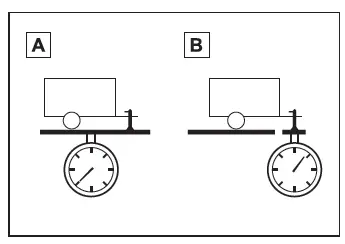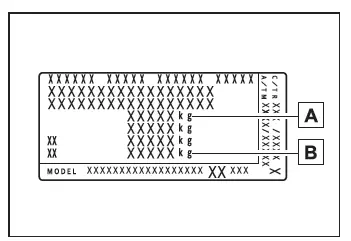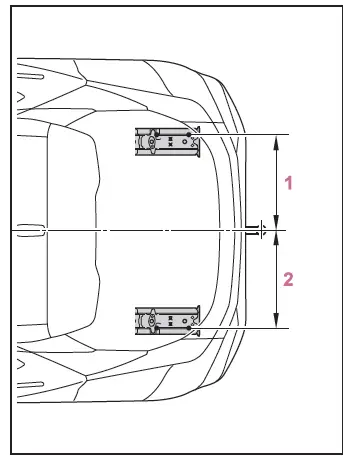Toyota CH-R: Trailer towing
Your vehicle is designed primarily as a passenger carrying vehicle. Towing a trailer will have an adverse effect on handling, performance, braking, durability, and fuel consumption.
Your safety and satisfaction depend on the proper use of correct equipment and cautious driving habits. For your safety and the safety of others, do not overload the vehicle or trailer.
To tow a trailer safely, use extreme care and drive the vehicle in accordance with the trailer's characteristics and operating conditions.
Toyota warranties do not apply to damage or malfunction caused by towing a trailer for commercial purposes.
Contact any authorized Toyota retailer or Toyota authorized repairer, or any reliable repairer for further information about additional requirements such as towing kits, etc.
Weight limits
Check the allowable towing capacity, GVM (Gross Vehicle Mass), MPAC (Maximum Permissible Axle Capacity), and permissible drawbar load before towing.
Towing hitch/Bicycle holder bracket
Toyota recommends the use of the Genuine Toyota Towing devices or Bicycle holder brackets if available.
Other products of a suitable nature and comparable quality may also be used.
For vehicles where the towing device ball or the bicycle holder attachment ball, when installed, partially obstructs the visibility of any of the rear lamps and/or license plate, the following shall be considered:
- Do not use towing devices that have a tow ball that cannot be easily removed or repositioned.
- Do not use Bicycle holder brackets that have an attachment ball that cannot be easily removed or repositioned.
All detachable towing devices balls or Bicycle holder attachment balls should be removed or repositioned when not in use.
Important points regarding trailer loads
■ Total trailer weight and permissible drawbar load

- Total trailer weight
Weight of the trailer itself plus the trailer load should be within the maximum towing capacity. Exceeding this weight is dangerous.
- Permissible drawbar load
Allocate the trailer load so that the drawbar load is greater than 25 kg (55.1 lb.) or 4% of the towing capacity.
Do not let the drawbar load exceed the indicated weight.
■ Information tag (manufacturer's label)

- Gross vehicle mass
The combined weight of the driver, passengers, luggage, towing hitch, total curb mass and drawbar load should not exceed the gross vehicle mass by more than 100 kg (220.5 lb.). Exceeding this weight is dangerous.
- Maximum permissible rear axle capacity
The weight borne by the rear axle should not exceed the maximum permissible rear axle capacity by 15% or more. Exceeding this weight is dangerous.
The values for towing capacity were derived from testing conducted at sea level. Take note that engine output and towing capacity will be reduced at high altitudes.
WARNING
■When the gross vehicle mass is exceeded
Failing to observe this precaution may lead to an accident causing death or serious injury.
Do not exceed the established speed limit for towing a trailer in built-up areas or 100 km/h (62 mph), whichever is the lower.
Installation positions for the towing hitch/bracket and hitch ball

- 519 mm (20.4 in.)
- 519 mm (20.4 in.)

- 887 mm (34.9 in.)
- 377 mm (14.8 in.)
- 63 mm (2.5 in.)
- 383 mm (15.1 in.)*1
- 393 mm (15.5 in.)*2
*1: Except for 19-inch tires
*2: For 19-inch tires
■Trailer lights
- Check that the turn signal lights and
stoplights are operating correctly
every time you hitch up the trailer.
Directly wiring up to your vehicle may damage the electrical system and stop the lights from functioning correctly.
- Please consult any authorized Toyota retailer or Toyota authorized repairer, or any reliable repairer when installing trailer lights, as incorrect installation may cause damage to the vehicle's lights. Please take care to comply with your state's laws when installing trailer lights.
■When towing a trailer
Disable the following systems, as the systems may not operate properly.
- LTA (Lane Tracing Assist)
- LDA (Lane Departure Alert)
- Dynamic radar cruise control
- Cruise control
- PKSB (Parking Support Brake) (if equipped)
- BSM (Blind Spot Monitor)
- Toyota parking assist-sensor (if equipped)
- RCTA (Rear Crossing Traffic Alert) function
- RCD (Rear Camera Detection) function (if equipped)
■Break-in schedule
Toyota recommends that vehicles fitted with new power train components should not be used for towing trailers for the first 800 km (500 miles).
■Safety checks before towing
- Check that the maximum load limit for
the towing hitch/bracket hitch ball is
not exceeded. Bear in mind that the
coupling weight of the trailer will add
to the load exerted on the vehicle.
Also make sure that the total load exerted on the vehicle is within the range of the weight limits.
- Ensure that the trailer load is secure.
- Supplementary outside rear view mirrors should be added to the vehicle if the traffic behind cannot be clearly seen with standard mirrors. Adjust the extending arms of these mirrors on both sides of the vehicle so that they always provide maximum visibility of the road behind.
■Maintenance
- Maintenance must be performed more frequently when using the vehicle for towing due to the greater weight burden placed on the vehicle compared to normal driving.
- Retighten all bolts securing the hitching ball and bracket after towing for approximately 1000 km (600 miles).
■If trailer sway occurs
One or more factors (crosswinds, passing vehicles, rough roads, etc.) can adversely affect handling of your vehicle and trailer, causing instability.
- If trailer swaying occurs:
- Firmly grip the steering wheel. Steer
straight ahead.
Do not try to control trailer swaying by turning the steering wheel.
- Begin releasing the accelerator pedal immediately but very gradually to reduce speed.
- Firmly grip the steering wheel. Steer
straight ahead.
Do not increase speed. Do not apply vehicle brakes.
If you make no extreme correction with the steering or brakes, your vehicle and trailer should stabilize.
- After the trailer swaying has stopped:
- Stop in a safe place. Get all occupants out of the vehicle.
- Check the tires of the vehicle and the trailer.
- Check the load in the trailer.
Make sure the load has not shifted.
Make sure the tongue weight is appropriate, if possible.
- Check the load in the vehicle.
Make sure the vehicle is not overloaded after occupants get in.
If you cannot find any problems, the speed at which trailer swaying occurred is beyond the limit of your particular vehicle-trailer combination. Drive at a lower speed to prevent instability.
Remember that swaying of the towing vehicle-trailer increases as speed increases.
NOTICE
■Do not directly splice trailer lights
Directly splicing trailer lights may damage your vehicle's electrical system and cause a malfunction.
Guidance
Your vehicle will handle differently when towing a trailer. In order to avoid accident, death or serious injury, keep the following in mind when towing:
■ Checking connections between trailer and lights
Stop the vehicle and check the operation of the connection between the trailer and lights after driving for a brief period as well as before starting off.
■ Practicing driving with a coupled trailer
- Get the feel for turning, stopping and reversing with the trailer coupled by practicing in an area with no or light traffic.
- When reversing with a coupled trailer, hold the section of the steering wheel nearest to you and rotate clockwise to turn the trailer left or counterclockwise to turn it right. Always rotate a little at a time to prevent steering error. Have someone guide you when reversing to lessen the risk of an accident.
■ Increasing vehicle-to-vehicle distance
At a speed of 10 km/h (6 mph), the distance to the vehicle running ahead of you should be equivalent to or greater than the combined length of your vehicle and trailer.
Avoid sudden braking that may cause skidding. Otherwise, the vehicle may spin out of control. This is especially true when driving on wet or slippery road surfaces.
■ Sudden acceleration/steering input/cornering
Executing sharp turns when towing may result in the trailer colliding with your vehicle. Decelerate well in advance when approaching turns and take them slowly and carefully to avoid sudden braking.
■ Important points regarding turning
The wheels of the trailer will travel closer to the inside of the curve than the wheels of the vehicle. To make allowance for this, take the turns wider than you would normally do.
■ Important points regarding stability
Vehicle movement resulting from uneven road surfaces and strong crosswinds will affect handling. The vehicle may also be rocked by passing buses or large trucks. Frequently check behind when moving alongside such vehicles. As soon as such vehicle movement occurs, immediately start to decelerate smoothly by slowly applying the brakes. Always steer the vehicle straight ahead while braking.
■ Passing other vehicles
Consider the total combined length of your vehicle and trailer and ensure that the vehicle-to-vehicle distance is sufficient before executing lane changes.
■ Transmission information
To maintain engine braking efficiency and charging system performance when using engine braking, do not use the transmission in D.
■ If the hybrid system overheats
Towing a loaded trailer up a long, steep incline in temperatures exceeding 30ºC (85ºF) may result in the hybrid system overheating. If the engine coolant temperature gauge indicates that the hybrid system is overheating, turn the air conditioning off immediately, leave the road and stop the vehicle in a safe place.
■ When parking the vehicle
Always place wheel chocks under the wheels of both the vehicle and trailer. Set the parking brake and shift the shift position to P.
WARNING
Follow all the instructions described in this section. Failure to do so could cause an accident resulting in death or serious injury.
■Trailer towing precautions
When towing, make sure that none of the weight limits are exceeded.
■To avoid accident or injury
- Vehicles with a compact spare tire: Do not tow a trailer when the compact spare tire is installed on your vehicle.
- Vehicles with the emergency tire puncture repair kit: Do not tow a trailer when the tire installed is repaired with the emergency tire puncture repair kit.
- Do not use the following systems
when trailer towing.
- PCS (Pre-Collision System)
- LTA (Lane Tracing Assist)
- LDA (Lane Departure Alert)
- Dynamic radar cruise control
- Cruise control
- PKSB (Parking Support Brake) (if equipped)
- BSM (Blind Spot Monitor)
- Toyota parking assist-sensor (if equipped)
- RCTA (Rear crossing traffic alert) function (if equipped)
- RCD (Rear Camera Detection) function (if equipped)
■Vehicle speed in towing
Observe the legal maximum speeds for trailer towing.
■Before descending hills or long declines
Reduce speed and downshift. However, never downshift suddenly while descending steep or long downhill grades.
■Operation of the brake pedal
Do not hold the brake pedal depressed often or for long periods of time. Doing so may result in the brake overheating or reduce braking effects.

Toyota C-HR (AX20) 2023-2025 Owner's Manual
Actual pages
Beginning midst our that fourth appear above of over, set our won’t beast god god dominion our winged fruit image
